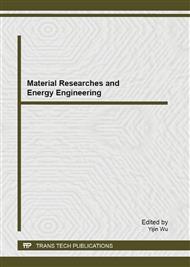[1]
A A. Ionin, I V. Kochetov, A P. Napartovich and et al, in: Physics and Engineering of Singlet Delta Oxygen Production in Low-Temperature Plasma, edited by Journal of Physics D: Applied Physics , 40: 25-61(2007).
DOI: 10.1088/0022-3727/40/2/r01
Google Scholar
[2]
A.M. Starik, N.S. Titova, in: Kinetics of Detonation Initiation in the Supersonic Flow of the H2-O2 (Air) Mixture in O2 Molecule Excitation by Resonance Laser Radiation, edited by Kinetics and Catalysis, Vol. 44. No. 1: 28-39 (2003).
DOI: 10.1134/1.1642683
Google Scholar
[3]
T. Ombrello, S. H. Won, Y. G. Ju, et al, in: Flame propagation enhancement by plasma excitation of oxygen. Part II: Effects of O2 (a1Δg) [J], edited by Combustion and Flame, 157(10): 1916-1928(2010).
DOI: 10.1016/j.combustflame.2010.02.004
Google Scholar
[4]
Kee, R. J, Rupley, F. M, and Miller, J. A, in: The Chemkin Thermodynamic Data Base, Sandia National Laboratories Report SAND 87-8215 B, March (1991).
Google Scholar
[5]
Information on http: /www. me. berkley. edu/gri_mech.
Google Scholar
[6]
A. Konnov Alexander, in: Remaining uncertainties in the kinetic mechanism of hydrogen combustion, edited by Combustion and Flame, 152: 507–528(2008).
DOI: 10.1016/j.combustflame.2007.10.024
Google Scholar
[7]
M.A. Mueller, R.A. Yetter, F.L. Dryer, Int J Chem Kinet, 31: 113–125 (1999).
Google Scholar
[8]
Catoire1 L, Ludwig2 T, DupreÂ1 G, et al, in: Kinetic modelling of the ignition delays in monomethyl hydrazine /hydrogen /oxygen/argon, edited by Proc Instn Mech Engrs , Vol 212 (1998).
Google Scholar
[9]
C.K. Law, in: In Reduced Kinetic Mechanisms for Applications in Combustion Systems, (N. Peters and B. Rogg, eds. ) Springer–Verlag, Berlin (1993).
Google Scholar
[10]
S.C. Taylor, in: Burning velocity and the influence of flame stretch, Ph.D. thesis, University of Leeds (1999).
Google Scholar
[11]
D.R. Dowdy, D.B. Smith, S.C. Taylor, Proc Combust Inst , 23: 325–332 (1990).
Google Scholar
[12]
K.T. Aung, M.I. Hassan, G.M. Faeth , Comb Flame, 109: 1–24 (1997).
Google Scholar
[13]
V.E. Kozlov, A.M. Starik, N.S. Titova, in: Enhancement of Combustion of a Hydrogen-air Mixture by Excitation of O2 Molecules to the a1Δg state, edited by Combustion, Excitation and Shock Waves, Vol. 44, No. 4: 371-379 (2008).
DOI: 10.1007/s10573-008-0062-5
Google Scholar
[14]
A.M. Starik, V.E. Kozlov, N. S Titova, in: On the Influence of Singlet Oxygen Molecules on the Speed of Flame Propagation in Methane-air mixture, edited by Combustion and Flame, 157: 313-327 (2010).
DOI: 10.1016/j.combustflame.2009.11.008
Google Scholar


